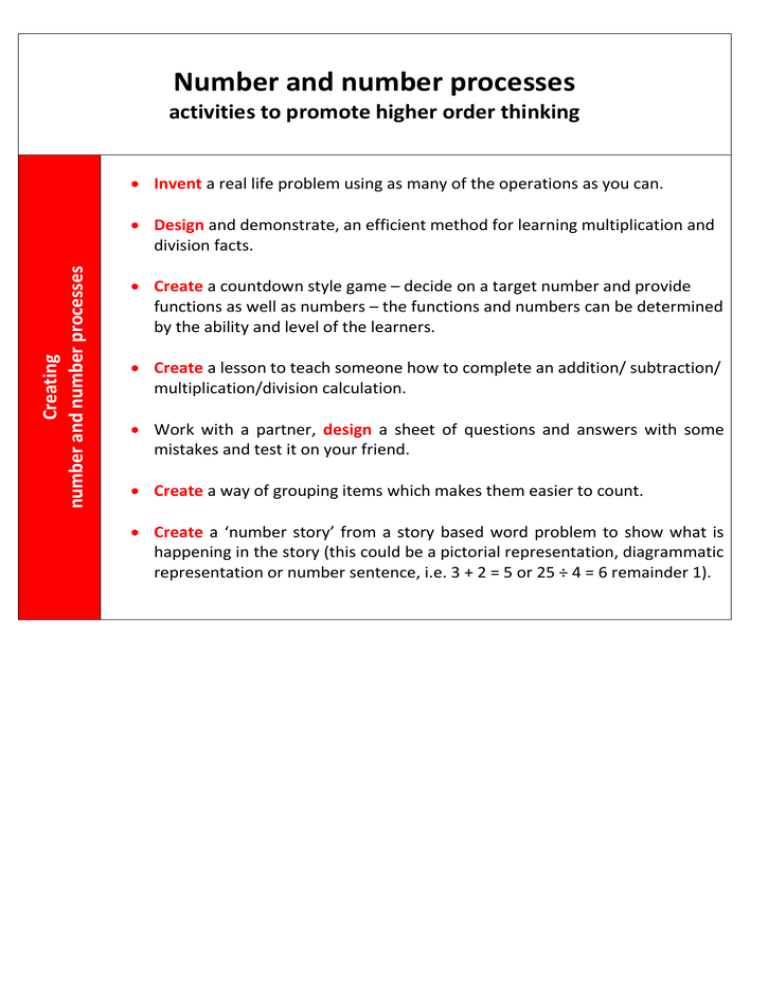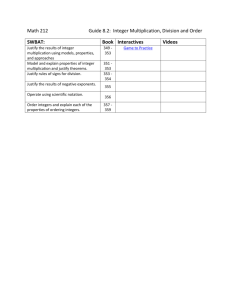Number and number processes activities to promote higher order thinking
advertisement

Number and number processes activities to promote higher order thinking Invent a real life problem using as many of the operations as you can. Creating number and number processes Design and demonstrate, an efficient method for learning multiplication and division facts. Create a countdown style game – decide on a target number and provide functions as well as numbers – the functions and numbers can be determined by the ability and level of the learners. Create a lesson to teach someone how to complete an addition/ subtraction/ multiplication/division calculation. Work with a partner, design a sheet of questions and answers with some mistakes and test it on your friend. Create a way of grouping items which makes them easier to count. Create a ‘number story’ from a story based word problem to show what is happening in the story (this could be a pictorial representation, diagrammatic representation or number sentence, i.e. 3 + 2 = 5 or 25 ÷ 4 = 6 remainder 1). Evaluating number and number processes Justify your choice of strategy to complete the calculation. Predict the effects of operations on different numbers and justify predictions (e.g. 24 + 4, 24 – 4, 24 x 4, 24 ÷ 4, 24 + 0.4, 24 – 0.4, 24 x 0.4, 24 ÷ 0.4, 2.4 x 0.4, 2.4 ÷ 0.4 etc). Decide then justify the most efficient method for… (e.g. multiplication, division, subtracting large numbers etc – number process appropriate to your learners needs & level) Explore the rule for Fibonacci sequence and explain the relationships between the Fibonacci numbers. Explain the distributive/commutative law to others and give appropriate examples. How do we know that … divided/multiplied by … is …? Prove it in your own way. How would you explain this to someone else? Analysing number and number processes Explain the relationship between the numbers in a calculation. Work with a partner to correct some calculations which show mistakes. Examine the answers to work out what went wrong. Staff: Make a suitable worksheet containing addition calculations/word problems – include some mistakes! Investigate then explain how lattice and line multiplication strategies work. Give out a range of number cards (the range can be dictated by the ability of the learners). Pupils must work together to organise their cards them into groups. Ask groups to justify why they grouped them in this way and why they rejected other grouping options. Explore mistakes, can you explain where the person has gone wrong? How would you help them to solve the question correctly? Decide whether objects have been shared fairly. Explain how you worked out how many … you needed? Applying number and number processes Understanding number and number processes Remembering number and number processes Use the 4 operations to classify a variety of word problems. Select the appropriate operation for word problems. Illustrate a mathematical story using appropriate number sentences. Explain which strategy is the most suitable for this type of calculation. Explain the strategy you used to work out the answer to a calculation. Tell me how you can make… Recall number facts





